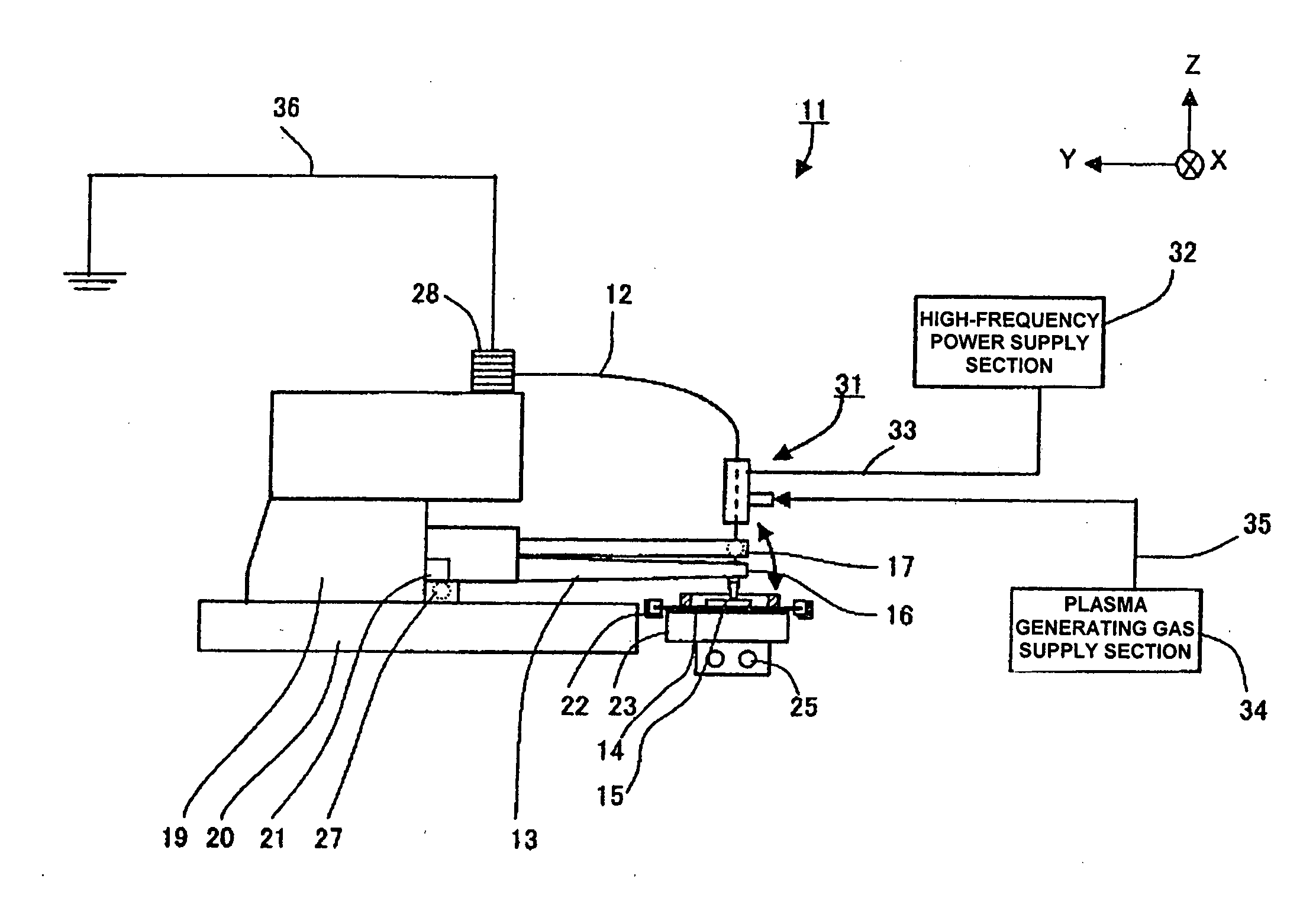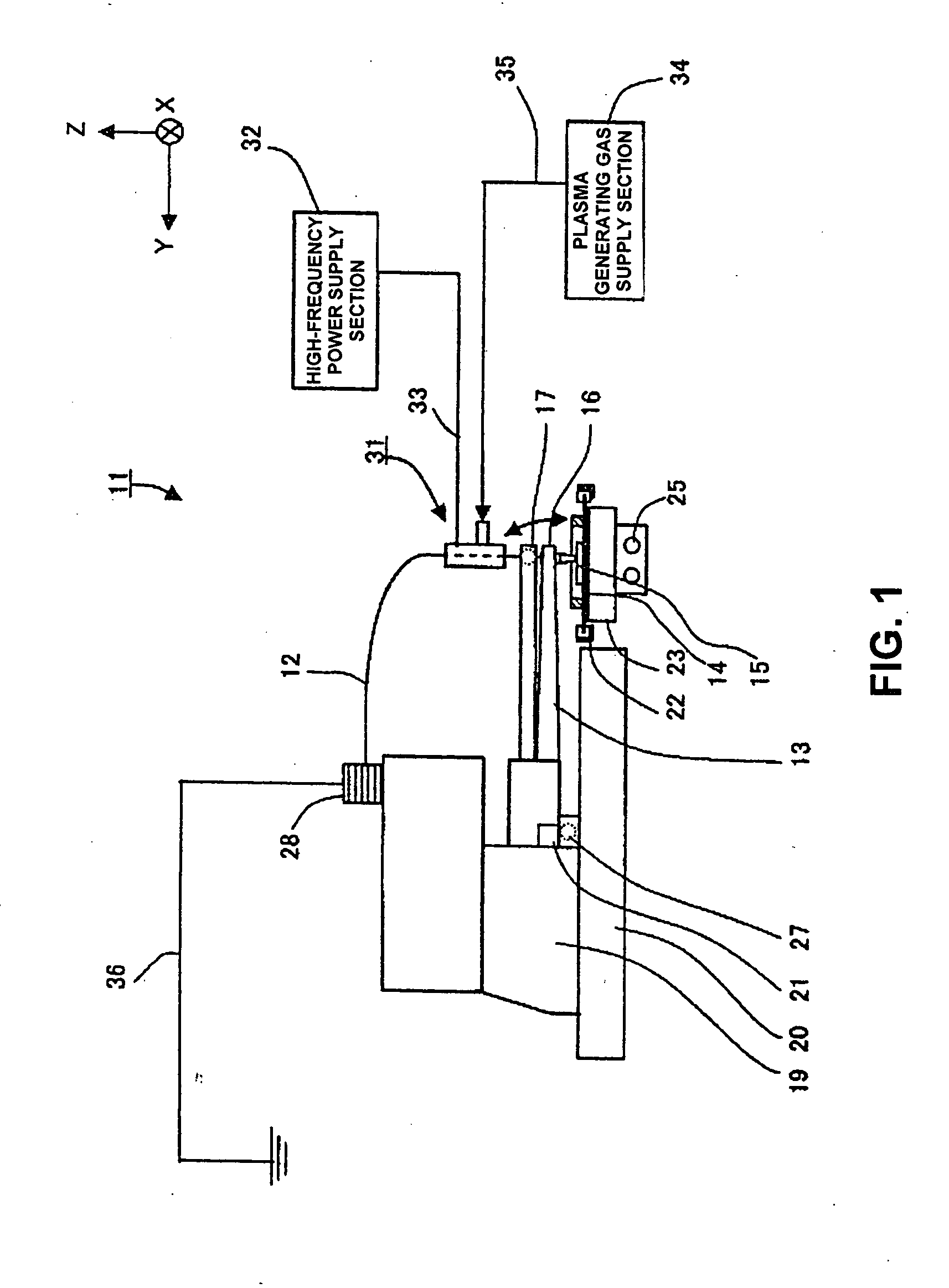Wire Cleaning Guide
a cleaning guide and wire technology, applied in the direction of manufacturing tools, soldering devices, auxilary welding devices, etc., can solve the problems of deterioration of bonding quality, metal wires such as copper, being susceptible to oxidized, and deteriorating gradually
- Summary
- Abstract
- Description
- Claims
- Application Information
AI Technical Summary
Benefits of technology
Problems solved by technology
Method used
Image
Examples
first embodiment
[0044]A wire cleaning guide 31 will be described in detail with reference to FIG. 2. The wire cleaning guide 31 includes a plasma generating chamber 41, a gas supply nozzle 42 for supplying plasma generating gas, and insulation bushings 43 and 45. The plasma generating chamber 41 has a cylindrical shape made of metal such as stainless steel with an inside space for generating plasma and is provided with end plates 41a and 41b, respectively, on the spool and capillary sides. The insulation bushings 43 and 45 are fixed to the center of the respective end plates 41a and 41b. The insulation bushings 43 and 45 are each composed of an insulation member and include guide holes 44 and 46 at the center thereof for guiding the wire 12 there through to guide the wire 12 as well as to provide electrical isolation between the metal wire 12 and the metal plasma generating chamber 41. Also, the insulation bushings 43 and 45 are adapted to keep the metal wire 12 separated from the inner wall of th...
second embodiment
[0052]A second embodiment will be described with reference to FIGS. 4 and 5. As shown in FIG. 4, the wire cleaning guide 31 according to the present embodiment can guide and clean the wire 12 as well as apply a tension toward the spool to the wire 12. Components identical to those in the embodiment described with reference to FIGS. 1 to 3 are designated by the same reference numerals and descriptions thereof are omitted. As shown in FIG. 5, in the present embodiment, the size of the guide hole 44 in the insulation bushing 43 on the spool side is greater than that of the guide hole 46 in the insulation bushing 45 on the capillary side so that the discharge amount of gas after cleaning flowing between the guide hole 44 and the wire 12 is greater than that of gas after cleaning flowing between the guide hole 46 and the wire 12. Therefore, since the force toward the spool that is applied to the wire 12 by the flow of gas after cleaning ejected toward the spool is greater than the force ...
third embodiment
[0054]the present invention will be described with reference to FIG. 6. Components identical to those in the embodiment described with reference to FIGS. 1 to 5 are designated by the same reference numerals and descriptions thereof are omitted. FIG. 6 shows a case where a dielectric 47 such as ceramic or glass is installed inside the plasma generating chamber 41, and the wire 12 is inserted through a guide hole 48 that is opened inside the dielectric 47. Since the dielectric 47 is made of insulating material such as ceramic or glass, the wire 12 can be electrically isolated from the metal plasma generating chamber 41 to be guided. For example, if the diameter of the wire 12 is 20 to 30 μm, the diameter of the guide hole 48 in the dielectric 47 can be 100 to 200 μm. Also, a gas supply hole 49 for communication between the gas supply nozzle 42 and the guide hole 48 is provided in a lateral part of the dielectric 47. The dielectric 47 can be formed in an integrated manner or can be div...
PUM
| Property | Measurement | Unit |
|---|---|---|
| frequency | aaaaa | aaaaa |
| diameter | aaaaa | aaaaa |
| diameter | aaaaa | aaaaa |
Abstract
Description
Claims
Application Information
 Login to View More
Login to View More - R&D
- Intellectual Property
- Life Sciences
- Materials
- Tech Scout
- Unparalleled Data Quality
- Higher Quality Content
- 60% Fewer Hallucinations
Browse by: Latest US Patents, China's latest patents, Technical Efficacy Thesaurus, Application Domain, Technology Topic, Popular Technical Reports.
© 2025 PatSnap. All rights reserved.Legal|Privacy policy|Modern Slavery Act Transparency Statement|Sitemap|About US| Contact US: help@patsnap.com



